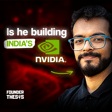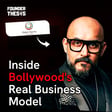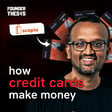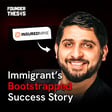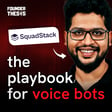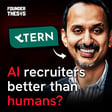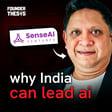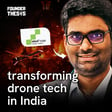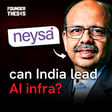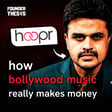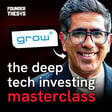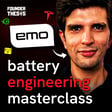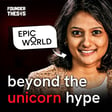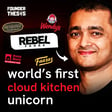Introduction to Market Research and Podcast
00:00:00
Speaker
Hi, everybody. Welcome to the Founder Thesis Podcast. I'm Rajiv Lamba. I'm CEO of Neurosensors. Globally, the market research industry is at least worth $100 billion. dollars We really are living in a world where everything is market researched. The ads you watch on TV, the packing designs of products you use, even the movies you watch. They have all gone through a validation process using market research. The reason for this is simple really. When a company intends to spend millions of dollars on a product, they want to reduce their risk of failure.
00:00:33
Speaker
In this episode of the Founder Thesis Podcast, your host Akshay Dad speaks with Rajiv Lamba, the founder of the market research tech company NeuroSensim and SurveySensim. In this freewheeling chat about entrepreneurship and market research, Rajiv shares valuable insights about the business of market research, building a business with profitability as the primary goal, and B2B sales. Stay tuned for this conversation and subscribe to the Founder Thesis Podcast on YouTube, Spotify or any streaming app.
Rajiv's Entrepreneurial Journey Begins
00:01:00
Speaker
So Rajiv, how did you end up becoming an entrepreneur? Tell me about that the the journey to starting up. So um this happened in Jakarta, Indonesia. In 2011, I joined an organization called Cadence International. That was in Jakarta. It was started by my friend and he started that in 2007.
00:01:31
Speaker
After four years, I decided to join him as as one of the shareholders. I was not the the sole entrepreneur or the owner of the company, but I was one of the early starters. Who were you at Who Who was ra okay who was i had that? one I was a market researcher. At that time, I was working in an organization called Nielsen.
00:02:01
Speaker
in Indonesia. So I was in the field of consumer research. At that time, I was very young. So I decided to to leave Nielsen to join a very small company. At that time, the world of startup was not there. It was like, I'm joining a business. I want to join. So the startup world was was not there at that point of time. So in 2011, I joined this company called Cadence International again in the field of market research. Very small organization in in Indonesia.
00:02:32
Speaker
which me and my um consumer, sorry, and I was a researcher, yes. Consumer research. That's correct. Okay. That's correct. So when I started, when I joined Cadence International, from there, till that time, the cadence got bought by one of the Japanese firm. So till 2011 to 2017, those six years gave me the the taste of entrepreneurship.
00:03:02
Speaker
because the company was very small and we really scaled it up. And then I was one of the early founder of their Vietnam office as well as their Middle East office.
Scaling and Acquisition of Cadence International
00:03:12
Speaker
So that six years gave me a taste of what a world of entrepreneurship is all about, the world of sacrifices, the world of investing into an organization. Not only that, I think also it's not about just scaling up, but also getting an earn out. So then the company got sold in 2014,
00:03:31
Speaker
i One of the Japanese for me is called cross marketing group. So they're also in the field of consumer research. They wanted more global scale operations. That's the reason they bought cadence. So from 2014 till 17, I got my own out. 17, I left cadence and I started neurosensing. So I think those six years really taught me how you build an organization.
00:03:59
Speaker
And then 2018, I started neuroscience somewhere. I went about fundraising and so on and so forth. Okay. Plus, you had the cushion of some of your own earnings through the sale. ah So it it was not like you were completely dependent on a salary. but Yeah, they definitely. I think I had that cushion of of getting an earn-out. It was not a massive earn-out, but it was decent earn-out for me to take a oh so to me to jump into being a sole founder. ah So that question was definitely there for me to start when I started New York and from that's correct. Yeah. Okay. ah You know, I've graduated from my MBA in 2002. And we had market research as a subject. And I
Founding Neurosensum and Technological Advancements
00:04:50
Speaker
There used to be projects in every subject. In our market research ah subject, the project was to actually conduct a survey and we would print out something and go to people and fill out the questionnaire in front of them. Is that how it happens now? or How does consumer research happen now? Something still, it happens broadly like the way you explained. The the world of me asking you and you telling me,
00:05:19
Speaker
So previously people were filling pen and paper. Now it has gone more into a tablet form. So that still happens a lot predominantly. But now there is also a world of online where I can just send you a link and you can just type on your mobile phone or on your desktop. So that's called online surveys. That has started coming a lot in our part of the world when I say our part of the world basically Asia. But if you go to the developed nations, a lot of that is a very online survey.
00:05:48
Speaker
Apart from that, there' there are a lot of more elements of technology which has come in. A technology like neuroscience, where without even asking consumers, you can understand their expressions. So that has taken a big shape in the industry in the last five, six years, which is going beyond what consumers claim. But I will not say the world has completely move up moved into a neuroscience base, but that's the transition which is which is happening across companies.
00:06:15
Speaker
And this is the idea that this is the bet you took when you started NeuroSensum, right? That ah there is a way to do consumer research in which you don't ask your consumers, but you read their expressions and decode them. That's correct. So I think I saw this in the US many early years. In fact, you know, when I was in my NBA time, oh that was way, way, way back, we had a small a document around this or small cases around that. But then I went to US and I used to constantly go to US at that point of time because the world of internet was not as as much as it is right now. So at that time, your only way that you could learn is to travel, to travel and attend conferences. So I saw this emerging field of neuroscience where I picked up lots of things and I started kind of reverse engineering and and learning.
00:07:15
Speaker
and And that's something I really fascinated me where the world was, was moving towards. And of course, then I took, up I took it on myself that, you know, I want to, i I was just getting bored with conventional way of doing research and clients were, not everybody was happy with that because you're telling a client to launch a product based on what consumers are claiming. And in Asia, people tend to be so nice and polite. And many times your recommendations, they were not coming through.
00:07:44
Speaker
And that the question was always the Holy Grail was, can I understand feeling and expression? And that's why I think neuroscience played a very important role in bridging that gap. And I was lucky enough to so see it, learn it, and then experiment it in Indonesia to begin with. And those early days of experimentation has now led to a big business is what I'm leading right now.
00:08:09
Speaker
Steve Jobs was famously anti-market research. I believe he said something like consumers don't know what they want until you show it to them. something i think but yeah yeah I've read that quote multiple times. you know If you ask consumers to create what they want to have, all those things are latent because they are hidden in their heart.
00:08:33
Speaker
ah People will not tell you that I need an ATM. They can only say that, oh, I want something. There's a hole that I can take the money from. Now, ultimately, a marketer converts them into an ATM. ah Very similarly, I think a consumer can never tell you completely what is hidden in their heart or the feelings. That is something that you have to decode. And um a conventional market research cannot always help you to decode those feelings. That's why I believe conventional market research really lacks um I'm still astonished that people are still using those traditional methodologies, even 30, 35 years ah from the time market research industry started. But I'm um'm happy that people have started understanding that there's a shift that everybody has to take. um And possibly that is because you know it takes a lot for an elephant to dance. Nobody gets fired choosing IBM. That's a classic story that we have heard. Got it.
00:09:26
Speaker
How did you tell me the journey from idea to the first ah revenue thank you know coming in? There must have been a journey of developing a product before you went out to market and all that. Just
Neuroscience Technologies in Market Research
00:09:43
Speaker
take me through that. like From when you decided to start it till the revenue started coming in, what was that journey like? so That journey was very interesting. and so there's There are multiple ways that you can do neuroscience-based research.
00:09:56
Speaker
So i I saw two or three different technologies. One technology was about the EEG devices. Of course, when we go to, will we know about the field of health care. When you go to neurologists, how they put the device on your head to understand how the brain is functioning. So I saw very similar devices. What's the full form of that, Joe? Yeah, electroencephaly flow gram. OK, OK, OK, OK.
00:10:25
Speaker
The sensors are stuck onto your scalp. Yeah. Yeah. Yeah. Reading your brain frequency or brain waves or something. That's correct. That's correct. but the But I think the idea was that they are very ah easy to use devices. OK, at that time, all the Western part of the world was using easy devices for neuroscience-based research. But some of them, they were using MRI. Some of them, they were using 32 electrodes with a complete headband. And consumers were getting very nervous around it.
00:10:56
Speaker
Thankfully, I think when I started in 2018, there were relatively easier devices, like a simple headband that you can put on the head. And we purchased some of those headbands. We didn't create the hardware. But then I hired a neuroscientist in India. And then we started doing multiple pilots ah with the consumers, of course, with their permission. just We tried three or four headbands. One was that six array device, which is basically reading the frontal part of your brain.
00:11:26
Speaker
and taking a single from there. And then with our neuroscience team, we started decoding, creating algorithms around it. We started testing those algorithms on different, different stimuli, on different, different advertising of products. And that was the early stage of how the entire ideation converted into a product. So that was one piece that that we created. It took a lot of experiments, a lot of internal funding. And that's where we fundraised because we wanted to test So many commercials around in Indonesia to begin with, as well as products or packaging to understand and create an algorithm which can be very, very accurate in predicting. So that was one methodology that we created. Second methodology was what I call as a pseudo neuro because nothing can beat a brain device, right? That's the epitome, but it can be a bit more expensive. Second is what we call as the implicit testing.
00:12:23
Speaker
And this is, again, an app that I saw in the US with one of the organizations. So the way implicit testing works, and magify it's been it's a time-based response. So if I show you a product, say, imagine this this is iPhone, and this is something, I'm going to ask you, just tell me, Akshay, yes and no. If I show you iPhone and I ask you, is it innovative? Yes.
00:12:52
Speaker
Okay, is Samsung innovative? Yes. Okay, see, in both the cases, you said yes. Right. So traditional market research companies, they are not named them, of course, everybody knows that. So they will tell you that both the companies are are innovative. But if I ask you to do that on an app, I will tell you in in your mind, iPhone is more innovative than Samsung. How do I know that? Because I've captured a speed of response. Of course, now I have not captured the time, but if if I asked you to do it on a phone, I'll be able to capture how many milliseconds you're taking. Right. So simple concept is that your brain has neurons and those neurons, they build connections, right? So anything which is more subconscious in nature, you will react faster. If somebody throws a snake at you, you will not think twice, you'll just move. If a car comes to your way, you will not think twice, you will immediately move. So that's called implicit testing. That's another way of measuring.
00:13:52
Speaker
a subconscious conscious brand positioning. So this is another app that we created where we could test out the brand position like the way I tested with you right now. So EG was one technique. Second technique was implicit testing. And then when we created this app, we created the algorithms in the background. Of course, consumer doesn't know what all you are calculating. So these are on that technique that from ideation stage came to um ultimately a commercial stage.
00:14:20
Speaker
yeah and other techniques like you know facial coding and eye tracking, which create which got created over a period of time. But these are the two techniques that we started with. Okay. What did you take to market first? The the device-based research implicit testing? The device-based came in first, and then we launched the implicit one. Okay. I guess the the device one is not really mainstream. right I don't think companies actually invite consumers, ask them to wear ah like a band with sensors. I think companies, they don't do it directly themselves. They normally hire consultants like us or organizations like us to do on their behalf. For example, you see everything around you is being tested, whether it's an ad or it's a product or a packaging. But organizations, they have a department called Market Research Department. Every organization has a consumer insights department.
00:15:17
Speaker
And we normally work with that consumer inside department. And they are the one who work closely hand in hand with us. So ultimately, we are the one who are executing on their behalf. And we are calling these consumers to our office um to to test their different stimuli that a client wants to test. OK. But is this mainstream? This device-based testing? I think when you say it's part of our business. It's a part of our business. I think when you say mainstream, of course, you can also buy these devices.
00:15:46
Speaker
A lot of these people, they use these devices even for a meditative purpose. Yeah, then say what these devices are are doing, I'll just quickly explain the concept to you so that everybody can understand the concept. Yeah, brain emits frequencies like alpha, beta, delta, theta, gamma. You would have heard about about them, right? And it it emits at a different frequency in hertz. Now, each of these frequencies, they ultimately connote something.
00:16:15
Speaker
Normally when we say that you're in an alpha zone, it means you're really relaxed. Okay. Okay. When you're in a gamma zone or ah or a delta zone, that basically means you're very hyper or you're very anxious about something. So when ah you're looking at something or you're eating something, if I put this device in your head, what this device is doing is picking up those, those signals from your brain, those frequencies. And we, as a neuroscience team has converted those frequencies into a marketing output.
00:16:46
Speaker
So when you are in a ah very high anxious state, we tell clients that which part of their commercial people are getting confused, which part of the commercial they are engaged, which part of the commercial they are confused. So we use these technologies to read brain, but we have converted them into a very simple logical marketing output. Is their product engaging? Is their product confusing? Is their advertising engaging? Which part of the ad is working, not working?
00:17:13
Speaker
which is boring, which is confusing. Yeah. So the broad parameters that you measure consumer response on is confusion and engagement. So the broad parameters that we we measure um are engagement, confusion, boredom, and snows. Snows is a state where you are physically you might be sitting, but you are completely detached. You are completely absent.
00:17:44
Speaker
from there. so So these are broadly four parameters that we measure. And on every stimulus beta packaging or or a or a product or an ad, we tell clients, where is there a product or an ad in comparison to competition? OK. And ah so you in your first go-to-market was the device-based testing, and then you started implicit testing.
00:18:14
Speaker
Yeah. Implicit testing is just taking signals around how much time you take to give an answer, or are there other signals also? Yeah. So basically, it's very time-based. I'm trying to explain a very layman language. So what we do is that we ultimately take the time into into consideration, right? And based on the time, we ultimately then we have created an algorithm which ultimately calculates and tells you which part of of the stimuli is more attached to you at a subconscious level. Yes. So it's a time-based technique. Okay. Okay. Okay. Got it. And then you launched facial coding. What is facial coding? Then we launched the eye tracking. Eye tracking, okay. Yeah. So basically eye tracking tracking, what happens with eye tracking, initially it was launched as a face-to-face mechanism. When I'm meeting you, ah and when you're looking at a stimulus, either on on a phone,
00:19:09
Speaker
or a laptop, be an ad, be a packaging, be a planar-graming. Planar-graming is basically a shelf, right, which is there in a supermarket or mini-market. So where are your eyes navigating? And this helps again a marketer to design their package. Remember, everything around you has been researched. Even a packaging has been researched. Should they put a big logo or ingredient or brand name? Everything has been researched, which is traditionally to a terminal claim basis. Now we are moving to eye-tracking.
00:19:38
Speaker
So this initially we started more as a face-to-face where either you're wearing a glasses like this with a sensor or between you and the and the laptop there's a eye tracking device. And I'm showing you something on the laptop. I'm measuring your eye gaze. And later on when we realized that the world is moving towards online research that I'm sitting here can do our online research in the US. And then we started something called the web camera eye tracking.
00:20:04
Speaker
that you give me an access of your web camera, and I'll take your permission. and i In the background, the algorithm is running, and I'm able to gauge your eye track movement. That's called the eye tracking gaze understanding, how much time you're spending, where you're spending time on the screen. It's done for UI, UX. For example, when you have a new website design, when you have a new app design, this completely has been moved into eye tracking based understanding. OK. OK.
00:20:32
Speaker
ah Does the webcam give that kind of resolution needed for tracking eyes? It it it is not as accurate as a device which is stationary. because you know ah See, a webcam on a desktop is far more accurate because your desktop is stationary. You might be moving a bit here and there. Of course, we give instructions to the respondent to be stationary. With a mobile phone, it's not very, very accurate.
00:21:04
Speaker
I think it gives you 80, 85% of accuracy because people can move a bit. But with a desktop, it's is's very accurate. With mobile, it's around 85% accuracy. OK. OK. OK. Got it. Got it. OK.
Challenges and Revenue in Neurosensum
00:21:18
Speaker
And what are the outputs coming out by measuring eye tracking? So see, the output which eye tracking tells you, no I'll give you an example. So I show you one pack, and I show you a second pack.
00:21:33
Speaker
So when you look at first pack, I will and i will understand how you're navigating. Basically, it gives you it's something called of a heat map in a technical term. But what it means in a very simple language ah la language, where are you focusing, how much time you're spending, and how are you navigating? And the output that it basically tells clients that, see, on a pack, if I'm a shampoo, I want to communicate aloe vera. I've got one aloe vera ingredient, and that's something I want to communicate.
00:22:01
Speaker
But if people are not even looking at my Eloe Vera ingredient, then possibly there's something lacking in my packaging. Either Eloe Vera is really at at the bottom, or it's very small, or Eloe Vera is not connoting Eloe Vera, it might be connoting Amla to some consumers, right? So those are things that eye tracking basically tells you that um where people are looking at and how much time they're spending. So we've got an option of packaging A, B, C. Which packaging is communicating what you want a consumer to understand? Second thing.
00:22:31
Speaker
If I show you a shell, like a planogram, because like in a supermarket, you've got a lot of products, right? Now every product wants to cut through from the planogram. What it basically means again in a simple layman language, ah that in a mini market, every brand is fighting for ah for a visibility space, not only standalone visibility, but whether you are able to see that or not as a consumer. So again, when we do a packaging testing using eye tracking, we understand Is there packaging cutting through in a shelf when other packs have also been placed? Which is again through a heat map. Which is again heat map. It's again heat map, time is spent, navigation, all of that people they get from my tracking. So this is what eye tracking output looks like. Okay, okay, okay. gar I guess a lot of app design company is user
00:23:28
Speaker
heat map software, which tells them where the mouse has gone. yeah This is like a ah version of that, which is telling you where the eyes have traveled, where have they spent time. Correct. Correct. Correct. Correct. Correct. Absolutely. OK. OK. OK. And so after eye tracking is when you launch facial coding. So what is facial coding? So when we launch facial coding, it has not been very successful for us. So I'll tell you why. So facial coding, what it does, it reads your facial muscles.
00:23:59
Speaker
like smiling or frowling. Yes, either you are smiling, you are a bit sad when you're looking at a stimulus. So that the entire output depends on how much is the movement of a facial muscle. Okay, so there are 54 or more facial muscles that you have and then they move. The algorithm is capturing those facial movements. And they are giving you an output whether you're sad, you're angry, you're distressed, whatever it is, right? So I'm just giving you some some ah but Now, the issue that I face when I we launch facial coding, and it has been consistent over the years, that as Asians, we don't, at least in a controlled environment, when I'm asking you to see something, ah until as that element is very are differently executed or very creatively different, people, they don't tend to move their facial muscles in a research environment.
00:24:55
Speaker
For example, when I'm speaking to you, possibly you might, I might see that a lot of times your facial muscles will be constant, which is a neutral zone. The issue with that is, with that happens a lot in an Asian context. In a Western context, we do see more nuances of a facial muscle. There's this classic thing that Asians, they speak through eyes, Western they speak through face. So we, in a research environment as as consumers, we don't really move our facial muscles too much.
00:25:23
Speaker
And that's one of the reasons you in a facial expression, though we created algorithm, we tested everything. But ultimately, we realized that average everything was coming neutral. Then 90% of the time, the facial muscles are not moving and it's coming in neutral to the zone. so So the entire objective of facial expression for a market research purpose was not getting solved. Of course, for a facial recognition as as a use case can be much wider for multiple cases. But for our use case in Asia, it was not giving the kind of results that we wanted and we never scaled up in Asia. But when we do it in the developed part of the world, we do still use facial muscles here or facial expression. Okay, got it. um So you know these in these business lines, the implicit testing, the device testing, facial coding, eye tracking, what is the revenue split between them? I'm just trying to understand which of these is like your hero offering. I'll say, the
00:26:21
Speaker
The hero offering number one is EEG. i we Among ah three of them. I think EEG, the revenue is from EEG. I said approximately 30% of our revenue exchange comes from EEG. 30-35% will be from EEG. um I'll say implicit testing gives another 30%. So it's almost near to the hero. And eye tracking bit gives the remaining part.
00:26:49
Speaker
yeah And we also do some conventional research on top of that, because not every client wants to move to neurostate on day one. So that's something that we also do. So I think I'll say EAG plus implicit are the top two products for us. OK, OK. So NeuroSense is a services company, or is it like a SaaS solution where the client does self-service? Or do you run service for them as an end-to-end service?
00:27:20
Speaker
So neuroscience has got two brands. One is a neuroscience based consulting that we have talked about in now. So that's a service business. Okay. But we also have a software called service and some which is a staff. Okay. So service and some is like a DIY survey platform. So not every time everybody can go to a consulting BS or others. So people have got so many questions about their consumer behavior understanding.
00:27:46
Speaker
When they cannot afford a consulting service, we we provide them service, and so which is our staff offering. ah ah Marketing services as an industry, purely as an outsider, I have the impression that this is like a very cutthroat kind of a business. There is no client loyalty. There is always turn and you're constantly hunting for new clients. Is that the case?
00:28:17
Speaker
ah You're talking about the services part or the sa part services I can tell you that our client retention has been around 95%. Now see, you're very you're very right and in pointing this out. And I think that happens at every industry which becomes a commodity. So when any industry becomes a commodity, then it's almost like, you know, whether we are, my you know, I eat this rice or milk, this is our kavai's kalu. So rice is the rice at the end of the day. starting When everything becomes a commodity, that's where the loyalty becomes very low. I think that's that's one of the reasons I was very, when I started this organization, I wanted to always differentiate versus what others are doing. I think for us, the loyalty being so high, because I'll say that we are possibly might be the top five neuro companies in the world right now, in terms of the tools and techniques and the output that we provide. And the clients has loved that them, number one.
00:29:13
Speaker
Second, because we originated from Asia, we are not as expensive as a US-based organization. That's number two. So we're able to provide our neuro offerings almost at the cost of a traditional offering. So a lot of other organizations which are giving traditional research, our neuro offering is almost matching that traditional offering. So they're giving something on top of what clients are getting from others and and not too much of a markup. And that has really helped us a lot in terms of differentiating our offerings and retaining the clients.
00:29:41
Speaker
and getting a higher retention. I think for me, as an entrepreneur, it's always and know the classic thing, either you differentiate or die. So if you are exactly selling what others are selling, then there's no fun of doing what you're doing.
00:29:54
Speaker
i try and try okay ah How operationally, how is it done? is this like a business which needs local presence, like your head office was Indonesia, but if you would get business from a Vietnamese company, you would need local presence in Vietnam to run the service, because especially when we're talking of the ah EEG survey,
00:30:19
Speaker
where someone you need someone who's trained on that and there is a physical device also.
Scalability and Costs in EEG Research
00:30:24
Speaker
So yeah how does it happen? like so you'll be very surprised that we do a lot of work in Southeast Asia setting out of Indonesia, with even with EEG. So what we have done, we have identified multiple partners. So when we get these inbound queries coming from either a Thailand or a Vietnam or a Malaysia, even from Taiwan. So what we have done, we have identified these multiple partners. And we have kept some devices with those partners, number one. And even in a country where we don't have partners, we are somebody to travel from Indonesia to that country.
00:30:57
Speaker
more form of fieldwork execution if if it's an EEG-based methodology. In that case, the lead can come from any part of the world. Execution either can happen through partners because we have trained those partners. If they can't, then somebody travels along with the devices to execute that project. I also think that post-COVID, a lot of where the businesses have happened has changed big time because and know previously, I used to travel a lot that you have to go to Malaysia to present to a Malaysian client.
00:31:27
Speaker
But now, ah sitting from any part of the world, we are presenting to any individual. The people also got used to being very comfortable, somebody presenting over over ah over a desktop, I think, over a Zoom or a Google Meet, that's the normal way. So I'll say that AEG has that limitation that you have to train your partners, you have to have the devices ready, or you're willing to travel, number one. But when it comes to implicit testing or eye tracking, that is very scalable.
00:31:58
Speaker
and yeah I don't need you physically to play on the app. I can just send you online links. You can fill your questionnaires online. You can do your app thing online or at eye tracking online. So that's very scalable for that anyway. You don't even need partners because the device doesn't need to be physical. It can still be on a very online. We call that as an online panel. It can completely be done online. As long as you have a good marketing and system to get the lead acquisition.
00:32:32
Speaker
By lead acquisition, you mean companies who want service done? Correct. The companies who want service done, right? either Other it comes to the inbound marketing lead or sales team reaches out to different part of the world just to present credentials and and generate the lead. Yeah. Okay. okay okay go' go The implicit and eye tracking test also must be significantly cheaper for a client, right? Yes, of course. because yeah Because I don't need to meet in the office every time. OK. Is it like a 2x difference in price or more than that? I think approximately half to a large extent, if it's done online. Yeah. I think very simple reason because you know easy you have to come to my office as a consumer. Yes. So that that cost of coming plus the device's cost becomes heavier. But having said that, EEG gives you the maximum accuracy in a neuron. Because you know reading a brain signal,
00:33:26
Speaker
It's far more accurate versus any other methodology, but it comes to the cost. And ah what are people testing in the EEG tests, like ad films? Ad films, products. OK. For example, i knew the packaging or like the features or what? like As in the taste test. So like, for example, you want to test your coffee vis-a-vis competitors. Biscuits, you want to test your tea.
00:33:56
Speaker
vis-a-vis competition. So this is what is called as a product testing. So taste testing thing is a very, very big field of consumer research. And this can only be done offline. This cannot happen online. So EEG cannot happen online because you need a calibration to happen. You need people to come physically to your office. So that's the limitation of EEG. Even the taste test would need offline or you can ship samples and run a taste test online.
00:34:23
Speaker
ah See, if you want to do a conventional research using for test testing, you can do it online also. But if you want to execute using EEG, then you have to have a person physically in your office. Yeah. OK, OK, OK. How much does it cost? And I mean, there would be so many nuances to it, like how many people are getting surveyed and the scope of work which would depend, I mean, would determine how much it would cost. But just help me understand through an example, like if a company wants this kind of survey done, this is what would be a ballpark cost estimate. So typically, any AG, I'll give an average value that we we have. Of course, it varies, as I said, right? Number of cities you want to do, number of sample that you want to survey. It's a function of both of them. But typically, the value will be close to $8,000 per project. We call it as per project.
00:35:18
Speaker
to $10,000 a project. So that's a typical value as an average across all. So we work with more than 350 companies right now across the globe. And that's a typical deals as you get per EAG project. Yeah. OK. And one project is going to answer one question. For example, does my coffee taste better than competitors? So that question will get answered in this one project. That's correct.
00:35:44
Speaker
That's correct. So typically, people can only come to us with with one particular use case that I like what you mentioned. Or can you please check my AdSense? You can also check two AdSense, by the way. Can you check my two AdSense vis-a-vis competitor? It can be done even in one project. Or can you check my two or three flavors that I have i want to launch vis-a-vis competitors? That can be part of one project. Yeah, that's called use case. OK. OK. Got it. Got it. OK. And how do you source respondents?
00:36:14
Speaker
Is that your headache or the company provides you respondents? That's our headache. So normally bigger organizations, they normally just outsource a use case that this is a problem statement that I have. So we don't have our own recruitment team. We normally work with the partners again. It's impossible to have ah your own team in every part of the world. It's impossible to work with different, different partners who help us to provide these venues,
00:36:42
Speaker
um these consumers based on the profile that a client wants. So we we pay to these partners as a part of the project. Yeah. Okay. Okay. Okay. Who are these partners? Give me an example. I will um but not be able to tell you the name, but these are called fieldwork partners. Okay. So these are agencies of their own and they specialize in recruiting this partner. Correct. Correct. Correct. These are not the consulting companies. They are the agencies of their own or specialized. Yeah.
00:37:11
Speaker
ah guarded garard Okay, okay, okay, okay. Understood, understood, okay. And and this neuroscience of business, like one or two more questions I want to ask, then we'll move into some. What kind of revenue do you estimate it to do this financial year?
00:37:28
Speaker
um I think that business for us is, see overall we are in double digit, a million dollars. Another, okay.
00:37:40
Speaker
So I'll not take, I can't tell you the exact number. I'm sorry for that. yes so businesses is combined are and will digit Yeah. combined as a company, we are at double digit million dollars on the, on the sales, approximately 65 to 68% of that is is a neuroscience based business. Yeah. Okay. And there's like teens, double digit by double digit, you mean in the teens? Early, early double digit numbers. Yeah.
00:38:06
Speaker
Got it, okay, understood, understood, okay. So when did the service and some diversification start? What is the story behind that?
ServiceSENSUM: An AI-Driven Platform
00:38:21
Speaker
ah This is a very interesting story. So when we went with, ah in Indonesian 2018, when we went to clients with neuroscience story, I think they appreciated that. And they also felt that these guys have some some good combination of right and left brain, which means they thought, okay, these guys know how to innovate. So when we were presenting neuroscience use cases and companies were using it, one very classic problem came from the organization. They said, no, I want to do so much of research, but the problem is I can't give you, can't come to you or any other consulting company, but I've got so much of queries which are coming from our marketing department, very simple reason because more brands are getting launched.
00:39:04
Speaker
More questions are coming to the consumer insights team from the marketing department, right? But they cannot ah go to a traditional company, a consulting company. And and the the issue was the traditional tools that they use, like SurveyMonkey, Typeform, Google Forms. They were not as advanced in terms of the dashboarding. Of course, you can create forms or questionnaires here. But when it comes to ah dashboarding, when it comes to reporting,
00:39:33
Speaker
These tools are not good enough. They can't give you the advanced level of dashboard or advanced level of reporting. So that is the problem statement that we understood. Second, these tools are very still very manually done. But there's no AI involved in those tools to a large extent. Because normally in a survey, you ask so many questions that, and some questions are very open-ended questions. Why you're happy? Why you're not happy? OK.
00:39:58
Speaker
now When it comes to the local language dialect, these tools could not understand the, they could not do the analysis of the local languages, right? Because service are asked in Hindi, in Bahasa Indonesia, in Thai, in Vietnam. So this is a big problem statement that we identified. And I said, okay, now what people ultimately, what realized that what people are ultimately asking for is a good customer feedback platform that they can use, but this platform should not be very manual in nature. so It has to have a very good AI element attached to it. So that people can read the data, dashboards can come, dashboards can ultimately tell them that your product is losing. And all of that automatically, somebody should also come. So that was a big part of the op problem statement, right? Why do I go to a consultant? Because consultant knows more than me. Consultant knows how to interpret the data. But if a software can interpret the data for you and can give you a chart that here's
00:40:53
Speaker
You have this problem statement. This is a survey that you can create. You can send to your consumers, your database. You don't have to create a chart. Dashboards will come live. Charts will come live. You can just click change chart type. But the software can also give you a complete summary. Your ad is not doing well. Why? Because this part of the ad was boring. People did not find it credible. People did not find it unique.
00:41:20
Speaker
If the software can automatically tell you that, then you don't need a consultant. You need consultants in very few cases in that case. So that's a big problem. You embedded the implicit testing and eye tracking technology into service and service. We have just started doing that. So when we started service and service, the problem statement was very simple that I want to do more research, but I cannot afford a consulting company every time. But can you please give me a software which is like a magic?
00:41:51
Speaker
that this traditional, old, fuddy-duddy software are not able to do. So that was the big problem statement that came in, right? Because every everybody can create a survey, or everybody can create a survey platform. But creating a survey platform which has that end objective requires a lot of capabilities from a tech perspective, from an AI perspective. And that's how we started conceptualizing this after we talked a lot of plans. And we felt that this is a big need gap, of course.
00:42:18
Speaker
Moving traditional consenting to newer is what we already done. But can we also create, fill this big big need gap so that everybody can do surveys, like an AI ratio, right? Everybody can fly. So every company can do surveys, and every company can do more surveys. So that's how service sensing got originated. where do you Now, if you look at service and some software, and if you try it out, you can create surveys. You can integrate that on your own ecosystem, which means if you have got a customer database which people were not utilizing. You will have so much of database sitting in the CRM system, but they were going to a consulting company every time to understand insights. But if you've got so much of customer database, you can also go to your own customers and service. And then we we've provided API integration on social media, app, CRM. So the idea that you can do in the moment real-time feedback on any channel that your customers are interacting with, you're able to get these dashboards real-time, you're able to get
00:43:17
Speaker
complete understanding of what is happening in real time. That's how a service engine came into picture. um It took us one and half years to design the basic part of the platform. And attack is always work in action, right? It's never stopping. But I think from that point to now, there's so much changes and innovation which has happened where I think our clients are able to do more service at a fraction of a cost. And at a very scalable manner is what service engine provides.
DIY Survey Platforms vs Consulting Services
00:43:45
Speaker
oh I'm going to kind of play a little bit of the devil's advocate. A Google form can give you the output in a Google sheet and on a Google sheet you can do pivot tables and whatever and get it. yeah like you can You can do analytics on that data with basic knowledge of how to use a spreadsheet.
00:44:10
Speaker
right so And for for a minute, let's not include the implicit testing eye tracking ah technology, which obviously is a differentiator. But if we put that aside, then what is the differentiator? You're right. A Google form can give you an Excel output that you can run a pivot table. yeah But I'll tell you what Google form cannot give you.
00:44:35
Speaker
right See, sometimes, you know as humans, we do not calculate the value of time. In developed part, people, they calculate the value of time because the time is expensive. In Asia, people, they don't calculate the value of time. So you're doing it yourself. You can still do it. But larger enterprises and mid-size enterprises, they calculate the value of a time as well as the value of a resource. So I'm not saying that SMEs have moved towards, but the focus has been large to mid-size enterprises. Because for them, hiring one more headcount is very difficult, number one. Second, a lot of these organizations, they want
00:45:07
Speaker
decision-making which happens on a real-time basis so much faster. By the time you convert those pivot tables into a dashboard, then you report to your CEOs, you can do that for one survey. What is if you have 10 problem statements in a day? Can you create those 10 charts? You will need 10 more analysts to do that, right? okay yeah i'll give you some I'll give you some more examples. when You cannot integrate a Google formula with your ecosystem. You can still do an API integration, but the issue is They don't have a ticketing system. What I mean by that? Say, for example, if you're using an airline, and the moment you booked a ticket, you were not happy with the entire experience, in a Google form, I will only know that somebody is not happy. They want to go item by item to understand, oh, who's not happy? Oh, Akshay's not happy. That will again take time. But in our software, when somebody is not happy, there's something called as a detractor alert, which is a closer loop. That's what these platforms are even more actionable than a consulting.
00:46:05
Speaker
So what happens at the moment, I know Akshay who has used my airline, suddenly his voter ticket is not happy and alert will go to my customer support team. And immediately a call will come to you so that before they lose you, they're able to retain you. And I tell everybody, you know, we always talk about four piece of marketing, traditional way, right? Products, placement, price, and positioning. But now customer experience has become a new differentiator.
00:46:33
Speaker
Because cost of acquisition is six times the cost of retention. That's what the software ultimately is able to do if you think from a code differentiator perspective. What are we doing? We are able to ensure that you are able to retain your customers by knowing that deep insights much faster. And that's what the traditional software they're not able to do. Like a ticket, real-time alerts, going to a customer support team. Integrity with the entire ecosystem, you don't need five different platforms. One platform can sit in the center, it can integrate with the chart,
00:47:03
Speaker
bought with your CRM system, with your social media, with your app, and everything is happening in one software. We can give you the dashboard, it's giving you tickets, it's giving you real insights. You don't have to create charts. You don't need all of those 15. And for for one of our clients in Indonesia, believe me, they had 20 endless because they were using the traditional survey platform. And the moment we implemented it, those 80 and endless were used for something else, right? And it takes so much of time at a fraction of the cost.
00:47:32
Speaker
So this is how the different session comes in. Okay, got it, got it. And the implicit testing, eye tracking, when will it go live into service sensor? I think by 2025, now we are working towards putting that as a part of the module, right? Initial vision when I had, when we started neuro sensor and when service sensor came in, I was anyway visualizing this that can client do a DIY plus neuro together in one. So now I think they're at a stage where we'll start putting these of algorithms as a part of the module. So imagine like in a DIY, you can either say survey platform or survey platform with neuro. If you click at that, it gives you access by tracking and implicit testing. That's a working proposal. Yeah, and then you can upload an ad and If you want our customer database, then we work with again partners and to so on and so So you have respondents available.
00:48:31
Speaker
or companies can send it to their own CRM entries? They can definitely do that because that's where the integration comes. But in case people, they want our help to do, like, for example, one of the Indian companies, they want to do service in the US because they've got a good business sitting out of the US. And in the US, everything has moved online in terms of the research.
Advice for Startup Founders
00:48:52
Speaker
That's what we, again, integrate with those partners, with the partners in the US who can help us to get these online responses.
00:49:00
Speaker
So ah an Indian company can create service, service can go to those partners, of course, they have to pay for the additional money on top of the subscription for the for the respondent access. But I think that's what the work in progress in 2025 actually, which is to put new element as a part of the survey element. okay Okay, interesting, interesting, ah which essentially would be like converting your, i to some extent, it'll cannibalize your services business, but then it the scale opportunity is much larger there. Yeah, that's correct. It might cannibalize some of that because some of the clients are coming to us as a consultant. But see, I think somebody else kill your killing you and your business, true it's better to cannibalize your own self because you know where the world will move towards. Yes, yes, yes, absolutely. Yes, yes, absolutely. yeah It's better that you
00:49:50
Speaker
take your services business away instead of someone else building a product and taking it away. right yeah um what is the i mean you know AI is such a buzzword today. Every product has AI in it. But is AI a core part of the product or is it like ah convenience? like For a lot of products, AI is basically making it more convenient to use the product.
00:50:18
Speaker
if you are using a like say If you're posting a job on LinkedIn, LinkedIn will write the job description for you yeah yeah through an LLM. So I just want to understand what is the use case of AI in service sensor. I'll say AI in service sensor is not convenient. It's a core. That core ultimately provides convenience. That is given. right How is it a core? What is it? I'll give an example. of Again, I think I'll i'll give you an example of the real use case. One of the biggest, there are two companies, I'll give you an example, one of the biggest automotive company in Indonesia, when they were sending their service before, before they use service and some, see in ah any service you also have something called the open-ended question. What is the open-ended question? For example, if you say, I'm not happy with your service, there's a subsequent question which comes, why you're not happy. right And when you type up those questions,
00:51:15
Speaker
And imagine you are sending this service to 1 million customers because you are sitting on a huge database, right? Now, traditionally, what was happening, these analysts were doing it manually. They were ro looking at this. Even it happens in the research agencies, by the way. right Research agencies, traditionally, are still doing it very manually. So this 1 million text comes in. All of this 1 million possibly, imagine 200,000 are not happy for whatever reason. And that text is coming in. And these analysts are manually tagging that data and analyzing it.
00:51:44
Speaker
and it is taking them two or three weeks even to tag analyze and give you the findings. Now with the help of NLP, your like natural level programming, it can identify those tags and give you the complete summary of what this actual data is all about. This has been used a lot in social media analytics and so on and so forth. But again, I think the native languages, text and sentiment like analysis at accuracy level was very, very weak, which has become better with the time.
00:52:15
Speaker
Now, something like this is, I will say, is a core. yes Does it provide convenience? Of course, it provides convenience, right? But that's a core differentiator that your algorithm can give you in any languages of the world. It can give you a predictive ah algorithm, which is making a summary of all all of this textual data, number one. Second, what I call as the NLG. Now, when this data comes in, where the dashboard data comes in, write you're getting all this chart.
00:52:44
Speaker
You have asked 50 questions, 30 questions, 20 questions on a scale of 1 to 5, 1 to 7. All of this is ultimately coming in a form of table or a chart. You have to read that chart manually and you have to interpret. And you have to interpret whether this is good or this is bad. Now rather than your brain interpreting it, if the automatic summary comes in, it's called automatic summary of a chart, which is a nice natural language generation.
00:53:09
Speaker
but okay Again, that becomes a core, but does it provide convenience? Of course, it provides convenience. I don't have to apply my own brain, but is is that that algorithm ultimately making me brain dead because my creativity and my brain cells are not functioning? There's a separate question in itself, but ultimately it's helping me to take a decision, take an informed decision because I'm able to get insights. Not everybody is good at generating insights. People know good with numbers can generate insights, right?
00:53:37
Speaker
Now these two things I'll say has become a core to me or to the platform or even to our client because they're getting so much benefit out of this. okay okay and so um I want to spend some time on Advice for founders around market research. and you know Since you've been from the industry and your clients are using you for their own market research needs, specifically like advice for startup founders on market research,
00:54:12
Speaker
um when should you actually consider outsourcing market research to an agency? like you know what level of maturity should your product have or what kind of revenue should your product be at for you to consider making that kind of spend to bring in a professional and, you know, invest in consumer insights and ah how, what are the benefits of that? but Because maybe at a very early stage, it may not be needed. Yeah. Something I'll say every startup should definitely gather consumer insights, right? Whichever can be the mechanism, but it should not be gut feel.
00:54:52
Speaker
still I see many organizations in Asia or around the world they might be running at even 200 crore business like a D2C brand and all but they're still using gutfield which is okay gutfield can take you to a level so using gutfield for like the packaging the ad films that they are making those are the things that they're using gutfield for yeah ah still I think in in many many organization people are still using gutfield okay because they want faster, they want speed. Now my thing is that whether you start a founder or even a small company founder, I believe the first thing that people should do is to understand that these consumer insights can give you, give them a lot of in information and they can take informed decisions. Sometimes people still go with their gut feels as a different case, but the idea is that, you know, can your decision making be better? Because people need to understand that every large organization become is becoming successful.
00:55:50
Speaker
the when they launch most of those products they become successful because back back consumer inside and that's number one point right so everybody should do whether it's a small company we come so how is it is a way of de-risking your product development and packaging and yeah advertising strategies like and a positioning right right okay and you know positioning right shall I When I'm creating a new concept, I don't need to wait for the product. I can just create a concept and test it out, right? So in a way, it's not taking away your gut feel. It's not taking away creativity because because your products are getting designed with the creativity. You can always take and some consumer feedback. Now the question is, do you need to hire a consulting company to do it for you or do you use, can you use something else? Then of course, if you, you don't have too much of money to pay, you can use these kinds of software, right? A lot of people, they don't know.
00:56:47
Speaker
lot of this software A lot of people still think that SurveyMonkey is the way to go, because that's the most popular platform or Google platform. But they don't know the better the solutions out there, which might not have the marketing budget like a SurveyMonkey. But I'll say every startup founder should search for these kind of tools. It doesn't matter whether it's a service or something else. And if you cannot afford a consulting company, use those softwares to take even better informed decisions. Whether these softwares are far smarter,
00:57:16
Speaker
ah and and you don't have to put too much of time and brain behind it. And then comes the third part, when the organization becomes bigger, there can be some complex situation where a software possibly cannot help you, where you start wanting to get a much more subconscious response. right That might be, say, a company which has become 500 crore and plus. They've got so much innovation going. They've got more budget. They're profitable. They can start spending more into market research.
00:57:46
Speaker
Because traditionally, people did just think, let me spend on the ad. That's good enough for me, right? So I tell everybody, start spending a bit more on market research. And when you've got a lot of innovations and you want to do this, because you know launching it, distributing it, even if it's fired a bullet, and you waste so much of money, and people ultimately, they don't re realize that these small elements can help them. Because I think possibly as an industry also, it has not become so popular in a large way. People, they don't know that what all this industry can do. So my belief is that Start with the basic software. If you're not that big, once you start becoming bigger, you you can allocate more budget. Go to the the consulting organization, especially when you want to talk about the consumer subconscious understanding. And what's the right way to design a survey? Are there any best practices that you want to share or is it like very, very contextual and not possible to give generic best practices?
00:58:42
Speaker
I think it's very contextual, but I'll say, you know, chat GPT has made our life simpler. Oh, okay. So ah of course, even in the software like ours, there are so many templates that we have put in. You want to design a packaging test, use this template. You want to design an ad test, use this template. But sometimes you might not like those templates, but I'll say, you know, chat GPT has been utilized by almost every industry. And law I normally see a lot of my clients.
00:59:09
Speaker
When they want to create a survey, but they cannot see a good template out there, then they just go to charge it and they keep on giving it from, and they get a question a lot of this. Right. Yes, yes, yes. True, true, true. That's good advice. ah What about somebody who's building like B2B, you know, either service or SaaS product? For such founders, what is the value of market research and how should they think about market research?
00:59:36
Speaker
I think if somebody is using a B2B product, be it services or be it SaaS, I think the value is same because for them, customer acquisition is important, but cost customer retention is equally important. So very basic surveys like Net Promoter Score survey, customer satisfaction survey, at different touch points, right from ah onboarding, ah why somebody is exiting. I think the question that you ask, ah when people we lose customer, are we serving those customers that we're losing or are we just waiting for our frontliners to tell us. And frontliners will only tell us what they do what you always don't want to listen, right? Or or they might just tell you, ah sir, just because there's a price, somebody left out, moved out. But the reality can be serviced. However, you want to understand retention. So don't focus on your acquisition, but also focus on the churn and retention. Look at that metric very closely and try to understand why it is happening. So I'll say consumer research possibilities are equally important to them.
01:00:36
Speaker
to understand their customers and understand their behavior. And if a company which is building a SaaS product wants to get the UI UX surveyed, get feedback on the UI UX of the product, then that would need a consulting company to enable that to happen because that sounds like hard to do through a platform.
01:01:03
Speaker
You can still do it through a platform. See, a lot of companies also do it in-house. See, of course, you can always go to a consulting company. Go into a consulting company for a UI-UX. You can always do that. See, lots of heat maps, like you mentioned, right? There are softwares which can help you do heat maps. But in case you already have some three UX designs, you can still go to a consumer and test on a platform. Like on a platform like Service Engine, you can add design one, design two, design three, and test what people are liking, what they're not liking. It can just quickly give you a new response. You can do this heat map internally using your own software so that you can embed this information on top of that and take more, you know what I call system one and system two together. System one is more subconscious coming from eye tracking as an output. System two is what consumers are rationalizing. You can always combine together and make an informed decision.
01:01:57
Speaker
Okay, okay, okay, understood. Tell me about fundraise. You just did that seed round, right? I think you have raised something like roughly two million dollars, till date? No, we have done much more than that. So in fact, we have done our series A plus 10 now. So we have done four round of fundraising. So I think from 2018 till 2022 end.
01:02:26
Speaker
So over these four years we did four round of fundraising. Total, how much have you raised?
Neurosensum's Growth and Market Expansion
01:02:31
Speaker
We'll have an exact number, but it it has been in in know and a single digit, early single digit number. Okay. um I think what is very simple reason, I think within four years, within three years we were moving towards a path of profitability. Within four years we became profitable as an organization. Of course, I think the idea was to get to profitability path as soon as possible.
01:02:56
Speaker
So we didn't even go to the double digit million dollars in terms of funders. I think within a single digit, half a single digit, we were able to you know sustain through. And I think, and we raised from some of the angel investors in the seed round in 2018. And then post that we raised from couple of VCs. One of that is alpha JWC in Indonesia, then SIG Asia. So these are a couple of VCs that we have on board. Yeah, and we were, I was just basic basically waiting for the right time to come when we really move away from a burn game. So we're getting a path of profitability for that. See, at the end of the day, you get respect when you build a sustainable business. Yes. And that's one of the reasons I was very conscious that we have to move there. You are a bit positive. Yes, we are a bit positive. We became a bit positive in 2000. We are still in single digit, a bit positive in the percentage.
01:03:55
Speaker
We are nearing double digit as we speak. so But I think in 2022, we got to our break even suppose that it has been a profitable venture till now. And so do you want to raise funds for maybe global expansion and things like that? I think that's what the plan is.
01:04:14
Speaker
he ah Profitability at a stage where we are right now um cannot help us to deep dive into a market like US, for example. but for For example, and I think we do have plans to expand to develop part of the world, well given that product that we have. And we know that we can really make an impact. um I think for for getting into those markets, definitely I think it requires a far bigger fund versus the profitability where we are right now. I think that's what the plan. I think in the next one year, definitely we will go there. Okay. What is your current country-wise split? Like what are the top countries from where you get your revenues? International number one, that's where we started.
01:04:55
Speaker
So I'll say Indonesia gives us approximately 60% of our top line. ah India gives us approximately 15 to 20% of our top line. And the meaning 20% comes from the ah Western part of the world. okay And I'll say that know if you look at this in 2021 or 2022,
01:05:23
Speaker
95% was Indonesia. So I think what happened in that period of time, so we continuously kept on growing, but the idea was to scale the business beyond a single country. And that's just what we looked at. A lot of inbound leads coming from different parts of the world and establishing India offers. Is India a profitable market? I think we have been in India for approximately two years, two years plus. So this year we will break even.
01:05:54
Speaker
are de businesso One is like your break even, but generally speaking for your kind of business, is this a lucrative market? I'll say ah right now looking at the business, I'll say yes. If you were asking this question five years back, you could have asked me a question, Rajiv, why you never did India before? and Because I somehow, you know, five or six years back, I felt that India was not ready for SaaS. India was not ready for this kind of product, but I was possibly wrong. Two years back when we tried this.
01:06:24
Speaker
It was possible. It began as an experiment, honestly. I think for a lot of independents, when they go to a new market, a lot of those new markets are experiments. I was very pleasantly surprised that India, people have already been educated to that level, right? ah See, in comparison to Southeast Asia, I have to compare. In Southeast Asia, I have to educate people on these products or these tools or these services. In India, people have heard about it. Might be somebody has done it, might be There's so much of education going on that people already got experience on it. So in India, I felt that the education pi bit was very less. It was more about just going and executing and telling the world that we have arrived here. So possibly that helped me a lot that I didn't have to educate the market, number one. I think what I also realized is, of course, you know if you look at CLB in India per customer, it is lower than what we get in Southeast Asia and it's much lower than what we get in the US.
01:07:22
Speaker
CLB is customer lifetime value. Yeah, lifetime value. Because the contract sizes are a little lesser. The bargaining is much higher. People negotiate much higher. I think that's what Indians are. We are all known. We also do that as individuals. The people, they tend to negotiate very hard, but I believe the volume compensates that less CLB or less contract value per customer.
01:07:47
Speaker
and And volume has become huge. I think I'll also say because um of there's so much fun which is coming to India. There's so much of funding has come into India. There's so many companies which are ready to take this on services, which was not their five years back. I think that has really given impetus to the industry, especially our industry. And to me, I think India has been a rising star for our own business much more than what I expected. And I'll say that, you know, our kind of services often might not be ready six years back.
01:08:16
Speaker
But I think it's a time right now, the way it is going. And the SaaS market in India is really doing well. what What is selling more in India, the SaaS or the services? ah I think it's a mix of 50-50 proportion right now. ah Okay, okay, okay. For the, what is your customer acquisition process? Like how how do you get customers?
Customer Acquisition Strategies
01:08:39
Speaker
Multiple channels. I say the the first is what I call as ah as a marketing.
01:08:46
Speaker
So we have a marketing team and we have a sales team. And they normally work in tandem. so And in marketing, we do multiple things. There's something called of the inbound marketing. Inbound marketing, in very simplistic terms, is when people are reaching out to you. When you're writing your content, you're writing your blog, and people are reading it, they're searching for it, and they ultimately, they go to your website and they put a query out there. So that's called inbound marketing. So inbound marketing gives us a lot of leads.
01:09:16
Speaker
which goes to the sales team, and this sales team approach the client. And then we present our credentials or our demos. That's one way of doing business. That is something that has been working well for us. And it's time to... LinkedIn? Like the BlackRock? No. The environment marketing is basically it's all SU, which is the search engine optimization on Google. And we do a lot of backlinking, guest blogs, content writing, content distribution.
01:09:44
Speaker
i Apart from that, we also do a lot of paid advertising, which we recently started. Till now, we did LinkedIn ads to build up top of the funnel, which is brand awareness. We have recently started a Google ad campaign and retargeting campaign, which basically is to build up the bottom of the funnel. OK. So this is a couple of things that we have started recently. I think that basically gives us knowledge. If someone read an article on your website, then that person will be shown an ad of your sensor or service and some when they are yeah dropping the net. So that's called retargeting. Got it. Google ad is very simple that you are bidding on a word. and When somebody is searching on that word on Google, ultimately, you are in front of them. Right. So these are what are called as a paid marketing, which is LinkedIn campaigns, Google ads, or we're talking retargeting campaign. So we do that, that helps us to acquire the leads.
01:10:43
Speaker
also is the lead. Then the sales team comes into picture in terms of contacting these clients. We do get queries from more than 30 countries right now across the world heading out of India. Took time three or four years to build that funnel. And other way that we generate lots of good leads is what we call as an event. Where we sponsor events, we become this the speaker in those events and ah we put a booth and people are not coming in those events, then comes the networking part. So I'll say these two channels have worked well. Third is what we call the cold outreach. and when When a salesperson is doing a cold outreach, that is another way of acquiring a ah but a customer. How much comes from cold outreach? Very less. I think my belief is that cold outreach is dead.
01:11:38
Speaker
good You know what, I've realized, Akshay, cold outreach has worked for us only when the brand has become popular. Okay. For example, in Indonesia, when the brand became too popular, initially cold outreach did not work. But the fact that a lot of people didn't know about neurosensors and service and stuff. Now, when they call, I'll say that for the for the viewers or for the listeners, a lot of people that think that, you know, I can just cold call and somebody and then somebody will give me um ah a meeting, it doesn't happen in large to mid-size enterprises, or it might happen in a smaller enterprises businesses, but it doesn't happen in the large to mid. So before you even go for a cold calling, I'll say that develop your marketing channel strong so that people are aware of you, go to events events, be a thought leader, because once you become a thought leader, people will come to you and talk to you. So try to do those funnels much better, which is a brand awareness.
01:12:37
Speaker
A lot of time people just say, okay, the simplest way is a 0.5 or 0.6 cold caller, like a call center. So do you need my car? and Do you need my car? That doesn't work in the SaaS atmosphere when you're selling to the big company. And that has been one of my learnings till now that you have to really build the brand, build the top of the funnel. Once people are aware of you, they have heard about you. Like everybody has heard about Salesforce. A lot of people have heard about Google and HubSpot. Once you build a brand, people will not ignore you.
01:13:04
Speaker
Right. Interesting. Okay. That's good insight. Okay. Okay. Okay. And which is where then fundraise becomes important for SaaS companies because they need to initially spend on brand building. Correct. I think for SaaS company, I think it's not only the brand building. The first thing they need to spend is on the tech. Yeah. You have to hire engineers, right? You have to hire data scientists, so on and so forth. And that's why you see SaaS companies take more time to get into profitability.
01:13:32
Speaker
Because first we'll come the innovation, then we'll come the acquisition, then we'll come the retention, right? And over time, we'll come the path of profitability and that takes relatively more time. in When we're selling a B2B product, I think that there are two broad approaches that companies take. One is like the PLG product-led growth, which is like, say, what maybe a like SurveyMonkey,
01:14:01
Speaker
would be a classic example of that. right ah Nobody from Survey Monkey would be cold calling customers, but Survey Monkey has a free plan and people sign up for the free plan and then they try to convert them purely through an online journey. that is like Say the Salesforce approach, nobody nobody signs up for a free trial of Salesforce. right You're always sold at Salesforce as a solution. ah What do you think will work for our survey center?
01:14:31
Speaker
What's your, like, what's your, I think very interesting question. I think it depends on the roadmap that a person wants to take. For me, I never wanted to become a server monkey. Okay. Now this premium model or in, it's called the inbound bond, complete inbound marketing model, right? Where you're doing this premium, you're writing a lot of content and you're getting these leads, you're giving a premium model, then you're selling for a thousand dollars a year.
01:15:00
Speaker
And SurveyMonkey already took that space to a large extent, right? And replacing somebody who has taken that space caused far more money. So I was very clear that I didn't want to become one more SurveyMonkey, number one. And having these kind of AI differentiators and to create one more SurveyMonkey with all the innovation, it doesn't make sense. So I was very clear that I wanted to go to larger enterprises and mid-size enterprises. So PLG root,
01:15:28
Speaker
or a premium route was not never an option for us. So for us, when we do these inbound marketing, we don't rely on free trials. We rely far more on demos. So when you come and say, no, sign up for a demo, I know that you're interested with me. When you go with the free trial, then what we do, we have people who come for the free trial. The small trial that we have kept there, very less. ah let be yeah And then we use email sequences to nurture them.
01:15:57
Speaker
or our tech team is monitoring and say, who's using my free trials more? And then we nurture them through the email so that I'm not wasting my time to individually contact a person who wants to pay me $1,000 a year. So that's a TLD model. It works very well for lots of companies. If you want to play that game, I didn't want to play that game. I think I wanted to go into a game like the way Salesforce has done or Microsoft has done. So that's the approach I wanted to create.
01:16:24
Speaker
of because we knew that who are we going to larger and better enterprises. Your point that SurveyMonkey is already occupying that space is not entirely accurate because SurveyMonkey has zero neuro-survey features. Yes. You are offering. So that makes it a fairly good Like that would possibly power your word of mouth and free trials. And I mean, essentially these products at the end of the day work through word of mouth and And if there is a product with the neuro-survey capability built in, and even if you allow people just, let's say 100 respondents in the free plan, yeah should work is what I think purely as an outsider, but I mean, I could be completely wrong, but. Yeah. No, I get what you're saying.
01:17:18
Speaker
See, ah when I say SurveyMonkey, I'm looking at customers in three segments. Others are larger companies, they're mid-sized companies, they're smaller companies. It's not that large companies and mid-sized companies are not using SurveyMonkey. They're still using SurveyMonkey because that's the most popular tool. They don't know any other platform. yes So my idea was to go to those organizations who can pay money. Some idea was not to go to a smaller enterprise. And now the point that you mentioned, who will value a neuro insight?
01:17:47
Speaker
A new site will be valued by more by mid to large. It's not that small company will not value. A small company first have to value research. Right. They have to first come into consumer research, then they have to come into neuro research. Yes. So for me, people are already into the funnel, like mid to large. Yeah. And for them, I wanted to give them a software which is far superior than a survey monkey and then move those thousand dollar deals to far bigger dollar deal because the software is far more capable.
01:18:18
Speaker
And these bigger companies, you know all of them, right? There are so many of them in India. And it's not that they can't pay money. They can pay money if they've got a superior solution, which is able to save their time. Because they're time bound. It's not that they don't have budget. They have budget. But my point is, when they have budget, why don't we give a superior tool and get a more value out of it? It's not a several monkey model cannot be classified. It can be.
01:18:46
Speaker
but Is Sarvamunki profitable after so many years of operation? Yeah, I'm not aware. OK. OK. I think it's been in operation for like, for what, more than 20 years possibly? Yes, yes, yes, yes, yeah absolutely. yeah and and And what is the valuation of that versus other companies which have done similar thoughts, which some of you need to compare. so For me, I didn't want to touch the small and medium enterprises. It was all about, you know. And see, at the beginning, you know, with all the still times that you have to be very clear and focused.
01:19:16
Speaker
What do you want to do? Who do you want to sell? If you're running helter-skelter selling to everybody, then you're selling to know but nobody. True. I think picking your core product and your core positioning for the product that you're selling becomes the most important thing.
Identifying the Ideal Customer Profile (ICP)
01:19:32
Speaker
yeah That's what it's called as determining what is the ICP, idle customer profile. The more early you strike your ICP, the more chances that you will become texas successful.
01:19:43
Speaker
A lot of what I've seen, companies or startups or founders, they make this mistake of going everywhere. They don't look at who's their ICP, who's their best bet. And they burn so much of money in that process that by the time they're coming, understanding who's their ICP, they burn a lot of money. And they're almost on their knees to raise one more round. And a lot of those founders, they end up with only 10 percent equity. All right.
01:20:09
Speaker
because they've done so much of fun bits because they're just running helter skelter touching everybody. Okay. Let me also sell to this. Let me also sell to that. And I think sometimes stepping back and having that wisdom and maturity to really understand what you want to sell to whom you want to sell and why you want to sell, you might take a bit more time. I could have easily taken survey monkey and cooperated and started with survey monkey, right? That would have been the easiest approach, but that was a no brainer approach.
01:20:38
Speaker
But going back and saying, you know, this is what my ICP can be. Go and test it out. Test the market. See whether there's a real market out there. Who who these large and ambitious enterprises are using? Are they using consulting companies? Are they using SurveyMonkey? And they were using both. So I started moving them from consulting to us to some extent and SurveyMonkey to us to some extent, right? Because with the software, they were able to get cheaper price and do far more superior than SurveyMonkey, but they can pay far more.
01:21:08
Speaker
Because they they can pay 100k to a consulting company. They can easily pay 10k for a service and some. Right. As long as it provides them the value. So I think do those elements are very important for any founder to to strike. Did you do market research when you were launching survey sets up? Of course we did. What was it that you discovered? So I remember then I told you the story in 2018 when clients told us that what all they want.
01:21:37
Speaker
and And we would have met more than. So in Indonesia, I think I personally would have spoken to around 70, 80 large to mid-sized enterprises because we were working with them. But we also went to the small enterprises. And that's what we understood there using Google form, Typeform, SurveyMonkey. And after we understood it, then we started designing it at a conceptual stage. We looked at the features around the world. We saw some of the other platforms. but and There are many other good platforms.
01:22:07
Speaker
And we started kind of researching, Googling, trying it out, checking. Then we created a concept out of it. That, okay, our product will have these, these screens were not ready. us and yeah Your UX takes time. But as at the concept level, then we presented those concepts offline. What if those are using SurveyMonkey? What if it provides you A, B, C, D? It will look like this. It's a journey to roadmap, will you try it? And that helps us to kind of design.
01:22:33
Speaker
That's what is called as an ideation or a conceptualization when you look at your competition landscape. If we can't do it being a market researcher, then we are not good researchers.
Choosing Indonesia as a Starting Market
01:22:43
Speaker
Right. You de-risk the product journey by yeah getting your clients involved at every step that and does the sound like an appeal. Absolutely. And they might not be able to tell you everything, right? You have to just go back and look, go back to the drawing board and start conceptualizing. I think that's a competition landscape.
01:23:02
Speaker
understanding different products out there. I think in the world where we are right now, you don't have to fly to a U.S. to learn everything. True. You can sit and you can attend some conferences virtually. You can do Google and you can know so many things which are happening.
01:23:16
Speaker
Yeah. Yeah. Yeah. Fascinating. oh Okay. Why are you ah incorporated and headquartered in Indonesia? Like you say headquartered in Singapore. Okay. Okay.
01:23:31
Speaker
But Indonesia is your primary market, right? through How did that happen? Indonesia is what we started. I think possibly because I was there for a long time. oh I had good connections. I knew though the market well. And when we started, I was physically based there. And my co-founder also has worked in Indonesia. His name is Mahesh. He's also worked in Indonesia for a long time. So I think that basically made a simple sense of starting in a market where we have been there for long. And that's how the business started.
01:24:01
Speaker
And is the business environment in Indonesia different from India? And how is it different? I think I'll say India is a far bigger market than Indonesia. I think if you if you say from that perspective, it's simple. The population is five to six times of what Indonesia is. I think what I see in Indonesia when um we launched the similar services in India, what I realized in Indonesia, we had to do a far more education because it relatively knew very few few people were talking about it.
01:24:30
Speaker
In India, I felt a lot there was a lot of more discussion which was happening in the boardroom around this. So ah we didn't have to we did not have to educate on the concept. but We would just go and tell. So in India, the challenge was, how are you superior to others? Global players. India is more globally aware of what's happening in the world. I think it was possibly because some people from the US, they tried selling in India before.
01:24:58
Speaker
right and and And people were more aware. Starting in here, it was, what is a different session vis-a-a the especially the companies that are coming from the US. In Indonesia, it was more about how different, ah how I can help you, and how these products can ultimately benefit you. It was more at the educational level. I think that's what the context difference was there. Okay,
Startup Philosophy and Team Building
01:25:23
Speaker
okay, okay. and just so okay ah Cool, let me end with this question. What's your advice to young aspiring founders? so
01:25:33
Speaker
that There can be so many of them that I can advise. I think my first biggest advice is when you're starting a company, first I think have the real reason of why you're starting something. That purpose of starting a business has to be there.
01:25:51
Speaker
And I've seen with a lot of young founders, the purpose of starting the business is that I want to make quick bucks. So that cannot be the purpose of the business. right You have to have a purpose which is solving a real problem. And if you're able to solve that problem, you will eventually make money. That's number one advice. Second, I'll say, I'll possibly say choose your team very very wisely.
01:26:18
Speaker
yeah Sometimes I do see young founders, okay, two friends, they come together, they have the same skill set. Two sales guys starting it together, not complementing each other is a very, it's not something which is so totally is desirable. People can still do it. But take your team which has which can complement, have your co-founders which are complementing what you're doing. Third, I'll say ah startup is not the bed of roses, okay?
Realities of Startup Life
01:26:48
Speaker
and And more than that, it's a bed of thorns. So to the outside world, when they see founders getting exit, and you know, we talk about the ATMs of the world. We talk about ah so many other founders have made a big bitcoin amount of money, but very few of them, they're able to, I think the fact is, I'll say 5% of the startups that survive for more than five years, 1% of the startups that survive more than 10 years. Okay. That's the official fact. so it's So it's a bed of thorns.
01:27:17
Speaker
that people have to be realizing that you know from the outside world, it looks very rosy and you see somebody getting really rich and say, oh my God, you know I want to get rich by starting a startup. That's not the point here. ye and I think possibly one more point I want to just add here, which is ah understanding your customer pain point is very, very important. right Don't be in a rush to raise too much, too fast, too soon.
01:27:48
Speaker
Sometimes people, they end up diluting approximately 50 to 60% of the stake while they're even in their series seed or pre-series round. I have only diluted closer to 25 to 30% of my stake or the company's stake even when we are in series B where we are right now. Because I wanted to keep it so that when you dilute, you dilute a higher valuation, not at a lower valuation. So there's been a hurry to dilute immediately.
01:28:18
Speaker
and And more importantly, I think the last thing is that the path of profitability has to be there right from day one in your mind. Your investors might tell you, I want 2x, 3x, 4x growth, but believe me, the moment your cash will go over, nobody will save you. Then you have to even go for a down round to save and you might have just been having five or 10% of the company and that really pends a lot. So don't raise more than what is required.
01:28:46
Speaker
have the path of profitability, have a very clear vision of what you want to build and who you want to work with and who are the investors that you want to have on board.
Concluding Advice for Founders
01:28:55
Speaker
Because that really determines what you will do because believe me, know it takes a lot of effort and sacrifice sacrifices to to build a good startup and a successful startup. I didn't have one advice, I think that there were five things that I wanted to share. No, that was amazing. Thank you so much for your time, Rajiv.



